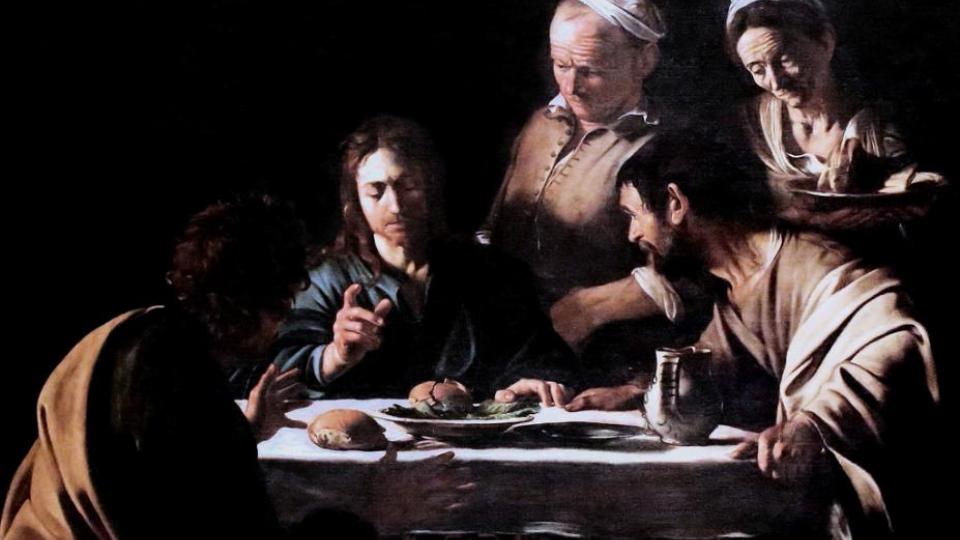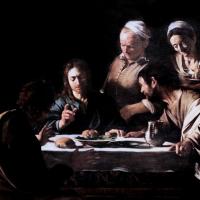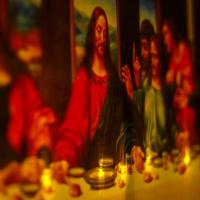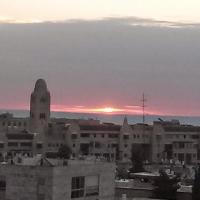Beth Immanuel is a friendly and welcoming community. Click here to learn what to expect when you visit.

Last Supper or Last Seder?
Was Jesus’ Last Supper a Passover Seder? On what day did Yeshua die, and did he celebrate a Passover Seder with his disciples or not?
Yeshua died on a Friday, but what day of the month was it? And by “day of the month,” I mean, on what day of the biblical calendar did He die? Was it the thirteenth day of Nissan, the fourteenth day of Nissan, or the fifteenth day of Nissan?
Maybe this seems like a trivial question, but every year around Passover, I receive questions about the timing of the passion week. People want to understand how the story of the death and resurrection of Yeshua fits together with the biblical calendar and the festival of Passover.
The question stems from a discrepancy between the way the Gospel of John and the gospels of Matthew, Mark, and Luke tell the story of the Last Supper and the day of the crucifixion. Some Bible teachers try to smooth over the discrepancy, cover it up, or outright deny its existence, but that does not really help the situation at all. Christian readers who are not familiar with the details of the celebration of Passover and the timing of the biblical calendar might never notice the problem at all. Thanks to ignorance about the Torah, most readers do not see the conflict.
John’s Chronology
When reading the Gospels from a Jewish perspective, however, the problem becomes obvious. In the Gospel of John, Yeshua has his Last Supper the night before the sacrifice of the Passover lambs (Korban Pesach). In other words, Yeshua conducts the Last Supper a full twenty-four hours before the Jewish people sit down to eat a Passover Seder meal. He is crucified the next day as the Passover lambs are sacrificed in the Temple courts. That night at sunset, the holy day sabbath (Yom Tov) of the first day of Passover begins. It corresponded that year with the weekly seventh-day Sabbath. In the Gospel of John, Nicodemus and Joseph of Arimathea close the tomb of Yeshua as the Yom Tov of Nisan 15 begins, right at the time when everyone would be sitting down to eat a Passover Seder meal. For that reason, the Gospel of John does not refer to the Last Supper (John 13–17) as a Passover meal at all. It makes no mention of Passover except to state that the meal took place “before the festival of the Passover” (John 13:1).
The Synoptic Chronology
The Synoptic Gospels of Matthew, Mark, and Luke tell a totally different story. John says that the meal took place “before the festival of Passover,” but in the Synoptic Gospels, the Passover is underway. In the Synoptic Gospels, Yeshua sends two disciples to sacrifice a Passover lamb and prepare an upper room for a Passover Seder meal. It’s the fourteenth day of Nisan. That night, the fifteenth day begins at sunset. The Yom Tov has already begun when they sit down to recline at a Passover Seder meal together. Yeshua says, “I have eagerly desired to eat this Passover with you.” The Synoptic Gospels depict the entire meal as a Passover Seder.
The Synoptic telling of the story implies that the Yom Tov of Nisan 15 (the special sabbath of the first day of Passover) has already begun and that the Last Supper is a seder. Accordingly, Yeshua is arrested on Yom Tov, tried on Yom Tov, brought before Pilate on Yom Tov, traded for Barabbas on Yom Tov, crucified on Yom Tov, removed from the cross on Yom Tov, and prepared and buried on Yom Tov. Moreover, a member the Sanhedrin purchases a shroud and supplies for his burial on a Yom Tov. As the tomb closes, the second day of Passover begins, coinciding with the onset of the weekly Sabbath.
Attempted Solutions
Scholars have recognized and puzzled over the discrepancy for centuries. Over the years, many commentators have made valiant attempts to reconcile and harmonize John’s version of events with that of the Synoptic Gospels. Most New Testament scholars today, however, have abandoned the quest. They are content to admit that John tells the story one way and the Synoptic Gospels tell it another way. That’s no fun. So let’s take a look at how people have tried to harmonize this problem in the past.
In his voluminous commentary, The Death of the Messiah, Raymond Brown categorizes and catalogues various attempts at explaining, harmonizing, and reconciling the discrepancy. Harmonizations attempt to rearrange the sequence. These usually accept the synoptic version and try to force John’s version to agree with it, but it requires them to ignore or explain away passages like John 18:28 which mentions that, when the Master stood before Pilate, the priesthood would not enter the Praetorium because they did not want to become unclean and forfeit their opportunity to eat the Passover lamb. In other words, the Passover Seder had not happened yet, and it was going to happen that night.
One theory proposes that the Galileans celebrated Passover a day earlier than the Judeans. Maybe Passover was always celebrated for two days in the days of the Master, as is the case in the Diaspora nowadays. If so, the Jewish people kept two consecutive Seder nights. None of these theories, however, find any corroboration in rabbinic literature or Jewish history. They have no basis in reality, and they would never have been proposed if not for the attempt to solve the discrepancy.
Another theory claims that the Synoptic Gospels were not actually describing a Passover meal, but a special meal meant to prepare for Passover. The plain reading of the Gospels makes that reinterpretation impossible:
And on the first day of Unleavened Bread, when they sacrificed the Passover lamb, his disciples said to him, “Where will you have us go and prepare for you to eat the Passover?” (Mark 14:12)
I will keep the Passover at your house with my disciples. (Matthew 26:18)
I have earnestly desired to eat this Passover with you before I suffer. (Luke 22:15)
In everyone of these verses, please note, the word “Passover” refers specifically to the Passover sacrifice, the lamb itself, which could only be sacrificed on the fourteenth day of Nissan and could only be eaten that night as the Yom Tov of the fifteenth of Nisan began. According to these three gospels, Yeshua told his disciples to go to the Temple, sacrifice a lamb as a Passover sacrifice, roast it, and bring it to the upper room. Our Master and his disciples ate more than just bread and wine that night—they ate the meat of the Passover sacrifice.
Finally, one popular theory explains that Yeshua and his disciples adopted the Qumran community’s solar calendar, which was apparently followed by the Essenes. That calendar works independent of the lunar calendar and places the Yom Tov of Passover on a Wednesday every year. According to the Essene calendar, the seder must occur on a Tuesday night. Those who advance this idea suggest that Yeshua and His disciples celebrated a Passover Seder in the home of an Essene, several days before the normal day of Passover was celebrated by the rest of the Jewish people. Some go so far as to suggest that Yeshua himself was Essene.
Most scholars have completely rejected the plausibility of this explanation. It requires an interval of several days between the arrest in Gethsemane and the crucifixion, not at all indicated in the Gospels. It also requires us to suppose that Yeshua followed the Essene calendar, which is totally out of character with what we know of Yeshua and his followers.
Evidence for John’s Chronology
Raymond Brown examines the internal evidence within the Gospels to see which account is most probable. He concludes that the chronology presented in the Gospel of John best fits the evidence. He finds several problems within the story in Matthew, Mark, and Luke, difficulties which make it difficult to accept that all these things happened on a Yom Tov, which Jewish people observed as a holiday sabbath. From a historical perspective, it is impossible to imagine first-century, religious Jews (even if they were Sadducees) carrying out a trial and condemnation and participating in a Roman court procedure on a Yom Tov. Not to mention Joseph of Arimathea purchasing supplies on a Yom Tov.
External evidence supports the Johanine version as well. The apocryphal Gospel of Peter tells the story of the trial and death of our Master. The Gospel of Peter never made the cut for the canonical New Testament. It appears to have been written in the late second. A sizable portion of it was rediscovered in 1886. The Gospel of Peter has no real credibility as a historically reliable source, but it at least tells us how the passion narrative’s chronology was understood in the second-century church. It records a conversation between Pilate and Herod Antipas which firmly places the Master’s crucifixion on Passover Eve.
When [Joseph of Arimathaea] knew that they were about to crucify him, he came to Pilate and asked for the Lord’s body for burial. Pilate sent word to Herod, asking for the body. Herod said, “Brother Pilate, even if no one had asked for him we would have buried him, since the Sabbath is dawning. For it is written in the Law that the sun must not set on one who has been killed.” And he delivered him over to the people the day before their Feast of Unleavened Bread. (3–5)
According to this passage, the execution took place on an Erev Shabbat and on the eve of Passover, i.e. Friday afternoon of Nisan 14.
A second piece of external evidence comes from the Talmud, tractate Sanhedrin (43a), where it says, “On the eve of the Passover Yeshu was hanged … he was hanged on the eve of the Passover.” One manuscript of the Talmud even says, “On Erev Shabbat and Erev Pesach Yeshua was hanged.” The Talmud has no better claim to historical reliability than the Gospel of Peter, but it does tell us how the passion narrative’s chronology was understood (and remembered) in the Jewish community.
If these sources are correct, and if the Gospel of John is correct, it seems that Yeshua could not have celebrated a Seder with His disciples the night before he died.
The Academic Answer
Raymond Brown and most scholars who have studied this issue advise letting go of the Synoptic Gospels’ version of the story. In other words, Jesus could not have kept a Passover Seder with his disciples. The Synoptic Gospels are simply wrong.
For example, Biblical Archaeology Review, Bible History Daily for April 11, 2014, offers a thorough article on this very topic. The article, by Jonathan Klawans, is titled “Was Jesus’ Last Supper a Seder?” Like Brown, Klawans looks at the evidence and concludes that we have to follow John’s chronology because the Synoptic version just does not make sense. So the academic world is ready to throw out the Last Seder presented in Matthew, Mark, and Luke.
Lichtenstein’s Answer
The academic solution does not work for us in Messianic Judaism. We cannot just throw out the testimony of three gospels. Fortunately, we do not need to dismiss the Synoptic version or John’s version.
Rabbi Yechiel Tzvi Lichtenstein’s nineteenth-century Hebrew commentary on the gospels proposes a harmonization which retains both the Synoptic version and the Johanine version without dealing violence to the text of either. His explanation is speculative, but he bases that speculation on solid Jewish sources to present how it could have happened (and apparently did happen at least once) that there were two days of Passover, back-to-back, perhaps in the year the Master died.
Lichtenstein’s explanation, however, is highly technical and requires the reader to have a great deal of background knowledge about the Jewish calendar, how it works, how it is reckoned, and how the holidays fit onto the calendar. Frankly, his explanation is beyond the scope of most gospel readers. Those interested in studying it out in detail can find the full argument with all the supporting evidence in my own commentary on the Gospels, Chronicles of the Messiah.
Lichtenstein explains that in the days of the Master, the Pharisees and the Sadducees had a great debate about how to observe Passover. The debate centered around the Counting of the Omer, that is the day of the first fruits of barley that begins the forty-nine day count off to Shavuot. The Torah says that the priests should offer the first fruits of the barley “on the day after the Sabbath” at Passover, but the Torah does not specify what it means by “the day after the Sabbath” (Leviticus 23:11). Does that mean after the Yom Tov of Passover or the day after the weekly Sabbath that falls during the seven days of unleavened bread? The Pharisees said, “It means Nisan 16, the day after Yom Tov.” The Sadducees said, “It means Sunday, the day after the weekly Sabbath (Shabbat Chol HaMo’ed).” The Pharisees always won these type of arguments because they had the strength of tradition behind them and they had the popular opinion of the people, the masses, supporting them. Whenever the Sadducean priests tried to do things the Sadducean way, the people revolted. They insisted on the traditional way. They literally forced the Sadducees to comply with Pharisaic tradition.
In those days, the new Sanhedrin determined the new moon and the beginning of the month by observation. Witnesses who sighted the new moon reported it to the Sanhedrin and the Sanhedrin declared that the month had begun.
Lichtenstein says that, in the year our Master died, Erev Pesach (Nissan 14) must have fallen on a Thursday. Lichtenstein believes that the Sadducees hired false witnesses to forestall the month by one day. They used bribes to influence the Sanhedrin to delay declaring the new moon by one day, therefore forcing Erev Pesach (Nisan 14) to fall on a Friday that year. This made the Yom Tov of Passover (Nisan 15) coincide with the weekly Sabbath.
Why did they do that? Because then they could keep their cake and eat it too. They were able to count the Omer and celebrate Shavu’ot the way they wanted because they had forced the festival Yom Tov and the weekly Sabbath to coincide, therefore fulfilling both the Pharisaic opinion and their own. In this way, they forced the whole population, just for that year, to keep Shavu’ot on the day they wanted. Naturally, some people rejected the ruse and kept Passover a day earlier, but the majority went along with the decision of the court.
What did our Master do? Lichtenstein speculates that, because Yeshua knew he would not be able to keep the Seder with his disciples on Friday night, he took advantage of the fact that some belligerent Pharisees were keeping Passover a day early, according to their own reckoning of the month. Yeshua went to the home of someone who was doing that so that he could eat the Passover sacrifice with his disciples a day before the rest of the nation did and before he suffered: “I have earnestly desired to eat this Passover with you before I suffer” (Luke 22:15).
Lichtenstein points out that this is not permissible ordinary circumstances. Ordinarily one should follow the majority and the ordained authorities that determine the Jewish calendar. Yeshua and his disciples followed the majority calendar and the authority of the Sanhedrin on other holy days. On this occasion, however, he had no other way to keep a final seder with his disciples. He joined the Pharisaic schism which was holding their seder a day before the day that had been declared by the Sadducees. The calendar problem that year made it permissible for him to do so because many people in Israel were doing so also.
Lichtenstein writes:
Yeshua did this rightly, for by the principles of the Pharisees, both of these days were valid as holy days, because the sanctification of the pilgrim feasts depended upon the court and upon the people of Israel; for it is Israel that sanctifies the times. Even if they err or act presumptuously, the day is still holy—as I suggest above—and Yeshua’s disciples understood this. It was only because his hour was near and he wanted to fulfill the commandment of the Passover that he joined himself with this sect, to eat his Passover on the fifth day in the evening. And if not this, he would have waited until the next day in line with the majority of Israel. That is why, I believe, his disciples imagined that he was asking Judas to buy things needed for the Feast, as it appears to me in John 13:29. For the main feast was the next day in the evening for the majority of Israel. Understand this.
It appears that divine Providence foresaw that in the year of Yeshua’s death, it would occur like this in Israel, so that the Master would eat the Passover with his disciples and would fix a “meal on the holy evening,” and along with this would be killed on the eve of Passover, thus himself becoming the true Passover lamb, as Paul writes in 1 Corinthians 5:7, and John in his Gospel at 19:36 (q.v.). (Lichtenstein, Commentary on the New Testament, on Matthew 26:18)
Lichtenstein finds support for this theory from the Talmud which describes how, on one occasion, the Sadducees bribed witnesses to manipulate the date of Passover. Lichtenstein says that this is further explained in the Rashi and Tosafot on the passage, and if you are interested, you can study the argument further in Chronicles of the Messiah.
Conclusion
Thanks to the machinations of the Sadducean-controlled Sanhedrin, the people of Israel were divided that year. Most people were keeping the calendar according to the ruling of the Sanhedrin as the Torah instructs, but some Pharisees refused. They kept Passover according to their own lunar reckoning. The Synoptic Gospels report the minority, sectarian, Pharisaic chronology for Passover that year whereas John reports the accepted majority reckoning endorsed by the (Sadducean) Sanhedrin.
Lichtenstein’s explanation is not bullet-proof, but it’s the most reasonable explanation I have heard so far, and I think I’ve heard them all. It’s the only one that has support from both rabbinic literature and all four Gospels. Rabbi Lichtenstein’s explanation has the advantage of bringing Matthew, Mark, Luke, and John together. We do not have to throw out either testimony. It allows us to accept that Yeshua did keep a last Passover Seder with his disciples, and he did suffer and die on Passover at the time of the Passover sacrifice, only a few hours before the majority of the people of Israel celebrated their seder that year.
This has implications for the Messianic Jewish observance of Passover. We should keep the Seder in remembrance of the Master as he instructed us to do. We should do so on the conventional seder night along with the rest of the Jewish people, but we should keep in mind that, in the year he died, our Master kept his Last Seder one night earlier than most people did. This was an exception, not his normal mode of operation.
Does it matter? I think it does. It matters because the integrity and reliability of the Gospel testimony is at stake. It matters because our Master told us, “Do this in remembrance of me.”
© D. Thomas Lancaster 2014 Torah Club: Chronicles of the Apostles
More Messianic Passover Teachings
Want more about Passover from a Messianic Jewish perspective? Check out our Passover page!




